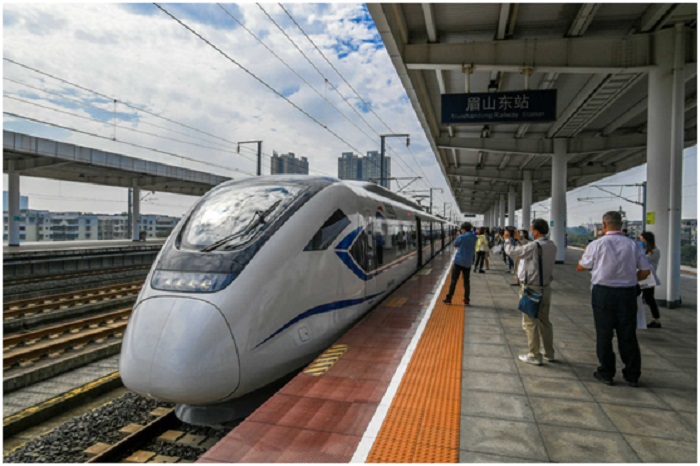



On the train C6252 departing Meishan East Station for Chengdu East station, Yu Youping was testing an application soon to be delivered on his laptop.
Yu, 35, lives in Dongpo district, Meishan, southwest China’s Sichuan province and works for a company 80 kilometers away from home in Wuhou district, Chengdu, capital of Sichuan. Thanks to Chengdu’s efforts to enhance inter-city rail services, now it only takes him 26 minutes to get to the provincial capital from where he lives.
At present, the 329 pairs of trains are running between Chengdu and the city clusters on the Chengdu Plain, up from 128 in the old days, and the daily passenger volume also soared from 83,000 to 250,000. In addition, the average departure interval has been reduced from 57 minutes to 25 minutes. The improved services not only facilitated the transportation of citizens, but also accelerated the gathering and circulation of economic factors such as personnel, logistics and information flow among the cities. The services have forcefully promoted regional economic development, as well as the integration of the Chengdu Plain economic zone.
According to Tang Jue, deputy director of rail transit department under Chengdu’s transport bureau, Chengdu has drawn inspiration from bus services in running its rail transit, improving the frequency of departures for its urban and inter-city rails. Passengers can enter the train stations with their public transport cards, and it’s as easy as taking a bus, Tang introduced.
Apart from Chengdu, the inter-city rail transit program covers seven other cities in the province, including Mianyang, Deyang, Meishan, Leshan, Ya’an, Ziyang and Suining. Under the support of China Railway and the coordination of China Railway Chengdu Group Co., Ltd., the program plans railway arteries, inter-city railways and urban railways as a whole, which has helped build a megapolis on the Chengdu Plain and meets people’s demand for faster and more convenient transport.
On September 29, Chengdu, Deyang, Mianyang, Leshan, Meishan and Ya’an jointly launched 11 bullet trains tailored for inter-city transit, which can run as fast as 200 kilometers per hour.
Yang Ping, deputy head of Chengdu’s rail transit unit, introduced that the 11 trains have installed ring pulls that are similar to those on buses. Compared with old trains running on the inter-city railways, the new ones have wider cars and are more spacious, which has tremendously improved the passenger capacity.
At present, trains running on the Chengdu–Zigong high-speed railway and the Chengdu–Dujiangyan intercity railway are also being added with bus-like facilities. Besides, Chengdu is constantly optimizing the transfer system for its inter-city railways and improving supporting public facilities. To ensure convenient transfer, Chengdu is optimizing shuttle services, parking and non-motorized transportation system at 27 rail transit stations.
A characteristic shopping district, Tianfu Bustling Town now lies near Xindudong station, a high-speed rail hub in Xindu district, Chengdu. It is a key cultural and tourism project built by the district. Around 80 percent of visitors are out-of-towners. Thanks to the convenient train and transfer services, the town has received over 3 million tourists this year.
The efforts to enhance inter-city rail services have accelerated the flow of personnel, logistics, capital and information, optimized the allocation of resources, advanced gradient transfer of industries, and promoted economic complementarity and integrated development.


The Executive and members of the.


The Acting Director, FCT Directorate of.


President Bola Ahmed Tinubu has been.



Barely a month after resignation of.


An Abuja based Legal Practitioner, Osuagwu.



Convener of Equitable Remedy, Mrs. Magaret.


Contractors handling the contract for city.


Nigerian government may have concluded plans.


The Diplomatic Correspondents Association of Nigeria.


A rights group, “Follow Me Talk.
Leave a Comment